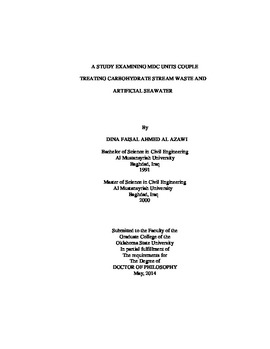| dc.contributor.advisor | Veenstra, John N. | |
| dc.contributor.author | Al Azawi, Dina Faisal Ahmed | |
| dc.date.accessioned | 2015-06-17T20:04:27Z | |
| dc.date.available | 2015-06-17T20:04:27Z | |
| dc.date.issued | 2014-05 | |
| dc.identifier.uri | https://hdl.handle.net/11244/14686 | |
| dc.description.abstract | Investing the biomass energy production in microbial desalination cells (MDCs) to drive another process like desalination has gained a great attention these days pushing researchers to try to unveil the limiting factors and overcome problems in order to scale up the MDC units and make a better competitor to another well adopted water-wastewater treatment technologies. Addition of BES inhibitor to deactivate methanogens contributed in increasing the power of the upflow MDC by 23% and that increase in power enhanced salt removal to reach 71% for reactor with inhibitor and 64% for reactor without inhibitor. The percentage removal of SCOD dropped when BES inhibitor was used to be 55% for reactor with inhibitor and for reactor without inhibitor was 64%. The results demonstrated that methanogen bacteria grow and compete for food whenever the loading rate is greater than the equivalent transfer load when operating MDC. Practically, deactivating methanogens can be approached through aeration rather than adding chemical. | |
| dc.description.abstract | When two reactors were connected hydraulically in series, salt removal percentage reached 86% and 71% of the SCOD (1.7 g SCOD/L/day) removed in the first reactor while about 8% removed in second reactor. The power density reached 61mW/cm3 while it was only 2.3 mW/cm3 in the first experiment using individual reactor. The results indicated that stacking cells can improve both salt removal and organic reduction. Examining membranes integrity after long term operation using scanning electron microscopy SEM along with EDS analysis revealed accumulation of biofilms on membrane surface (anion exchange membrane AEM) that could seriously hinder the migration of anions from the cathode compartment to the anode. The influence of long term operation on cation exchange membrane (CEM) was not significant as AEM. Investing the electricity produced by MDC bacterial metabolism to drive salt removal is considered promising; however the ability of such system is just to handle low organic loading rate (max of 2 g COD/L/day) and above that with the performance will drop. That made such system fit perfectly as post treating system following another waste stream treatment such as a digester. While the reduced salt stream may need further treatment such as RO to fit the purpose it designed for. | |
| dc.format | application/pdf | |
| dc.language | en_US | |
| dc.rights | Copyright is held by the author who has granted the Oklahoma State University Library the non-exclusive right to share this material in its institutional repository. Contact Digital Library Services at lib-dls@okstate.edu or 405-744-9161 for the permission policy on the use, reproduction or distribution of this material. | |
| dc.title | Study examining MDC units couple treating carbohydrate base stream waste and artificial seawater | |
| dc.contributor.committeeMember | Wilber, Gregory G. | |
| dc.contributor.committeeMember | Sanders, Dee Ann | |
| dc.contributor.committeeMember | Johannes, A. J. | |
| osu.filename | ALAZAWI_okstate_0664D_13291.pdf | |
| osu.accesstype | Open Access | |
| dc.type.genre | Dissertation | |
| dc.type.material | Text | |
| dc.subject.keywords | carobhydrate waste | |
| dc.subject.keywords | mdc | |
| dc.subject.keywords | seawater | |
| thesis.degree.discipline | Civil Engineering | |
| thesis.degree.grantor | Oklahoma State University | |
